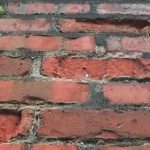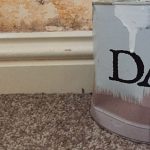The DIY Fix is reader supported. When you buy after clicking a link on our site, we may earn an affiliate commission.
In this article, we are going to be looking at how you can identify a failed damp proof course. Including how this can cause damp problems in your home, and more importantly how you can fix it.
If you have identified rising damp in your home, it is likely due to a problem with your damp proof course. Below, we’re going to discuss whether your original damp proof course can fail, including how this can happen. Finally, we will look at fixing a DPC. Don’t worry, there are some DIY methods for fixing a faulty DPC. These don’t cost the earth and are usually quite simple.
Can your original damp proof course fail?
Yes. In fact, it is one of the biggest causes of rising damp in a building. When a damp proof course fails, it allows moisture to enter bricks and mortar. The materials in your home act like straws pulling moisture up from the ground. A DPC is installed to prevent this from happening. When a damp proof course fails, moisture can find a way in.

When a DPC fails, and moisture begins to enter the brickwork of a building, this is called rising damp. A home with rising damp will have a DPC that has failed. Or it may never have had a DPC installed in the first place.
Even a properly-installed damp proof course, may only last for about 20-25 years. An incorrectly installed DPC likely won’t last this long. Also, if your home has a DPC that wasn’t installed correctly, it may have been letting moisture into the brickwork of your home for some time. But how can you tell if your damp proof course has failed? Are there signs? Well, let’s explore that next.
How to tell if your damp proof course failed
Of course, if you’ve found this DPC article, chances are your home is showing signs of damp already. But how can you tell why this damp is happening? Well, the damp gives us clues. If you have a damp ‘tide mark’ on the exterior or internal walls of your home, this is a sign of rising damp spreading up your walls.
Penetrating damp leaves isolated patches of damp on the walls of your home. Rising damp, on the other hand, rises up through the brickwork. So, if your damp is at a consistent level on the walls of your home, you have rising damp.
If you have rising damp, it is likely your damp proof course has failed, or wasn’t installed at all. Either way, you need to fix your DPC. Rising damp typically only rises to about 1.5m on the walls of your home. After that, gravity takes affects, and the water cannot rise any more. So, if there is evidence of damp up to this height, it has been caused by groundwater.
Other tell-tale signs of rising damp include:
- Peeling wallpaper
- Damaged skirting boards
- Peeling or blistering paint
- Mould growth
- Salt deposits
Salt deposits are an excellent indicator of rising damp. These white marks are from minerals in the earth. These deposits do not occur with other types of damp. You may also notice damage to your flooring and floor joists. Of course, these can be harder to spot unless you have exposed floorboards.
What if my property never had a damp proof course?
Some older buildings do not have damp proof courses installed during building. Older buildings (built before the 1940s) used lime mortar to prevent moisture from entering the home. These older buildings also had nice, thick walls to stop moisture being an issue. However, all this means, is that damp may still enter the building. It just takes longer to show any signs. If you live in a property that was built before the 40s, there may have been damp in the brickwork for some time. You just happen to be the unlucky occupant at the time it decided to rear its ugly head.
Older buildings can still greatly benefit from a DPC being installed. In fact, if your property hasn’t ever had a damp proof course, you should install one. If you think that your home has never had a damp proof course, don’t worry. The DPC solutions below can still be used. Let’s look at how to fix a failed damp proof course now, shall we?
How do you fix a broken damp proof course?
Installing the original DPC from scratch would be complex and costly. This involves removing sections of the brickwork to add the new damp proof course. You then replace the bricks and mortar and move onto the next section. This isn’t a job for someone without experience. You will need to hire a professional for this type of job and it can be quite expensive.
Thankfully there are other methods to repair a DPC. The methods below are cost-effective and excellent alternatives. Also, a few of them can be done by someone with good DIY skills too. Here are the ways that you can fix your failed damp proof course:
DPC injection
Damp proof course injection is one of the most DIY friendly form of fixing a DPC. This involves a chemical in liquid or cream form. This is injected into the fabric of your home at the level of the old DPC. It creates a water-repelling layer that will stop damp from rising. Chemical DPC is widely available. All you need is a drill capable of drilling holes in the bricks, and to follow the instructions!
Damp Proofing Rods
Damp proofing rods work a bit like the DPC injections above. They are inserted into holes drilled at regular intervals. Once inside the brickwork, the damp proofing rods will repel water. They cure over time and form a protective layer. Damp proofing rods are very easy to install and will keep your home protected for years.
Electro Osmotic DPC
When using a chemical DPC isn’t an option, this method is often used. An Electro Osmotic damp proof course uses wiring to create a small electric charge in the walls of your home. This electric charge reverses the capillary action in bricks and mortar. So, rather than the brickwork sucking up moisture, it pushes it below the level of the new DPC. This method of fixing a failed DPC is best left to the experts. Oh, and it is totally safe, by the way.
Conclusion
A failed damp proof course can lead to considerable damage if left untreated. The good news is there are quick, easy, and affordable solutions. Most can be performed as a DIY project and can offer the same protection as your original DPC.
If you are looking for a DIY solution for your failed damp proof course, a chemical DPC, or damp proofing rods are probably the best way to go.
Both are quite simple and if you can follow simple instructions and use a drill you should find the process quite easy.




